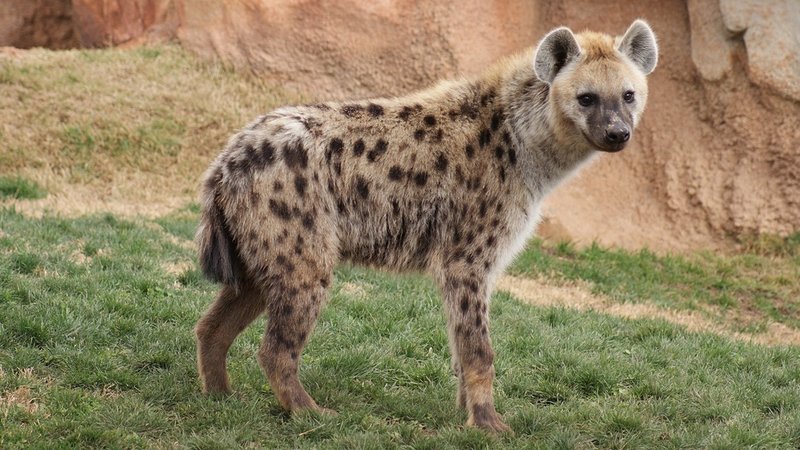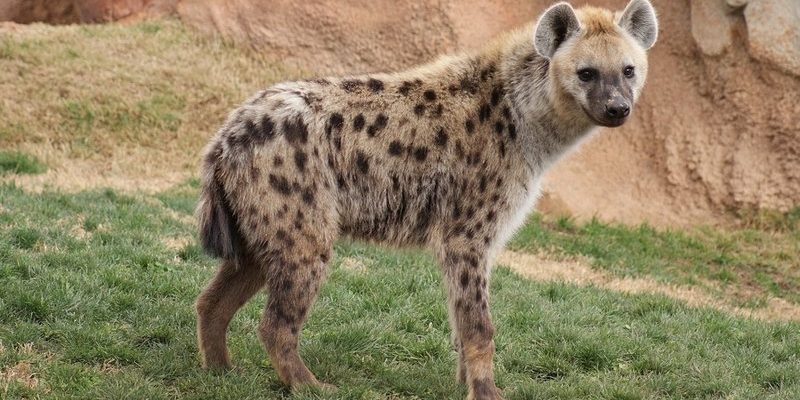
Imagine you’re at a wildlife park, surrounded by a diverse mix of animals. It can get a bit overwhelming trying to differentiate them, right? That’s exactly why we’re here—to break it down for you, sip by sip, as if we’re chatting over coffee. Let’s take a closer look at these fascinating creatures and learn what makes them unique while keeping the brown hyena in mind.
1. Spotted Hyena
The spotted hyena is perhaps the most famous of the hyena family. Often recognized for its strong social structure and distinctive laugh, it has a few features that set it apart from the brown hyena. For starters, spotted hyenas have a more robust build and a larger head adorned with larger ears. Their coat is covered in spots, which adds to their unique appearance.
You might also notice their social behavior. While brown hyenas tend to be more solitary, spotted hyenas thrive in large groups called clans. This social structure allows them to work together in hunting and scavenging. If you’re out in the wild, keep an eye on the group dynamics; that can help you distinguish between these two species.
Physical Differences
– Build: Spotted hyenas are sturdier and bulkier.
– Ears: They have larger, rounded ears compared to the brown hyena’s smaller, more pointed ears.
– Fur Pattern: The spotted hyena has a coat that’s, well, spotted, while the brown hyena has a shaggy, more uniform coat.
2. Striped Hyena
Next on our list is the striped hyena, which might remind you of a more ancient version of the brown hyena. Found mostly in North and East Africa, this creature has a more slender appearance and, as the name suggests, stripes on its back. Unlike its distant cousins, the striped hyena has a less sociable nature and prefers a more solitary lifestyle similar to that of the brown hyena.
Here’s the thing: while both the striped and brown hyenas share a certain shyness, the striped hyena tends to have a more pronounced facial structure with a longer snout. If you ever catch a glimpse of a striped hyena, look for those stripes—they’re a dead giveaway.
Key Features
– Coat Pattern: Look for stripes along the body, especially on the back.
– Facial Structure: The longer snout makes the striped hyena stand out.
– Behavior: They tend to be more solitary, much like brown hyenas.
3. African Wild Dog
The African wild dog is another fascinating creature that shares some similarities with the brown hyena. They both inhabit Africa and have a penchant for living in packs. However, African wild dogs are known for their beautiful, mottled coats, which consist of patches of black, brown, and yellow.
Here’s a fun fact: they’re considered one of the most social animals in the wild. Their cooperative hunting strategies often lead to successful catches. If you encounter them, you’re likely to see them working together, which is quite different from the more solitary brown hyena.
Differences in Hunting and Social Behavior
– Cooperation: African wild dogs are incredibly social and hunt in packs, unlike the more solitary brown hyena.
– Appearance: Their unique mottled coat is eye-catching compared to the brown hyena’s shaggy fur.
– Size: Typically, African wild dogs are smaller and leaner than brown hyenas.
4. Coyote
Moving across the ocean, we find the coyote. These adaptable canines roam North and Central America. While they don’t share the same habitat as the brown hyena, they do share some hunting and scavenging behaviors. Coyotes often work in small packs, similar to brown hyenas, allowing for efficient hunting.
However, coyotes have a more slender appearance, long legs, and a bushy tail that’s quite different from the brown hyena’s build. Plus, their vocalizations are more versatile, ranging from howls to yips, which gives them a distinct auditory personality in the wild.
Main Differences
– Proportions: Coyotes are generally smaller and have a more slender build.
– Voice: Their vocalizations differ greatly from the brown hyena’s signature laugh.
– Habitat: Unlike the brown hyena, coyotes prefer a variety of environments, from deserts to urban areas.
5. Dhole
The dhole, or Asiatic wild dog, brings a unique flavor to the mix. Native to Asia, dholes have a striking reddish-brown coat, similar to the hue of the brown hyena. They’re highly social animals that hunt in packs, which creates a dynamic teamwork approach akin to that of African wild dogs.
What sets them apart, though, is their incredible adaptability to different environments. Dholes thrive in various habitats, from forests to grasslands. If you ever spot one, you’ll notice how different their tails are: dholes have long, bushy tails that add to their unique charm.
Spotting the Differences
– Color: While both are brownish, the dhole has a more reddish coat.
– Tail: Dholes have bushy tails, unlike the brown hyena’s less prominent tail.
– Behavior: Dholes are incredibly social and vocal, often marking their territory with sounds.
6. Jackal
Next up is the jackal. These clever creatures are found in Africa, the Middle East, and even parts of Asia. While jackals are generally smaller than brown hyenas, they share some scavenging habits and can often be seen foraging in pairs or small family groups.
Jackals are known for their intelligence, often utilizing cunning strategies to find food. Unlike brown hyenas, they’re more adaptable and can survive in various habitats. If you ever see one, take note of its slender body and pointed ears, which are quite different from the brown hyena’s more robust build.
How to Differentiate
– Size: Jackals are smaller and leaner than brown hyenas.
– Ears: They have larger, more pointed ears, giving them an alert appearance.
– Behavior: Jackals tend to be more versatile and less solitary than brown hyenas.
7. Fossa
The fossa might not be what you think of when considering hyena relatives, but it’s an interesting comparison from Madagascar. This cat-like creature is the island’s top predator and has some scavenging habits. Fossa have elongated bodies and long tails that help them navigate through trees—quite different from the brown hyena’s ground-dwelling nature.
What’s fascinating about fossas is their agility and hunting prowess. They’re known for preying on lemurs, showcasing their adaptability and skill. If you see a fossa in the wild, you’ll notice its sleek appearance is distinct from the more robust brown hyena.
Key Comparisons
– Body Shape: The fossa has a more slender, cat-like build.
– Habitat: Fossas are arboreal, meaning they spend much of their time in trees, whereas brown hyenas are terrestrial.
– Diet: Fossas primarily target small mammals, while brown hyenas are more scavengers.
8. Tasmanian Devil
Crossing over to Australia, we find the Tasmanian devil. Known for its fierce reputation and devilish screeches, this small marsupial has similarities to the brown hyena when it comes to scavenging behavior. Both species have strong jaws and are capable of consuming bones, which is a handy trait in the wild.
However, the Tasmanian devil has a stockier, more rounded body compared to the leaner brown hyena. Their dark fur and unique facial features—especially that famous grimace—help set them apart. If you ever hear their eerie vocalizations, you’ll surely remember the encounter!
Distinguishing Features
– Build: Tasmanian devils are stockier and rounder than brown hyenas.
– Vocalizations: Their sounds are quite different, often described as eerie or menacing.
– Habitat: Unlike brown hyenas, Tasmanian devils live in forested areas.
9. Caracal
The caracal is another fascinating creature that can lead to interesting comparisons. This medium-sized cat, known for its striking ear tufts, roams Africa and parts of the Middle East and Central Asia. While caracals are primarily hunters, they occasionally scavenge, similar to the brown hyena.
Physically, caracals have a sleek and muscular build, perfect for their agile lifestyle. They’re also known for their impressive jumping ability, which allows them to catch birds in mid-air. If you spot one, take note of how different their body structure and ears are compared to the brown hyena.
How They Differ
– Build: Caracals are leaner and more muscular than brown hyenas.
– Ears: The distinctive tufted ears are a signature feature of the caracal.
– Hunting Style: They primarily hunt small prey, unlike the more opportunistic scavenging of brown hyenas.
10. Meerkat
Lastly, let’s not forget the adorable meerkat. These social creatures are from the mongoose family and are famous for their upright stances and curious nature. While they’re not in the same family as brown hyenas, they both share a social structure, living in groups called mobs.
Meerkats spend their days foraging for insects and small vertebrates. They also have a unique form of communication that helps them alert the group of any danger. Physically, their small size and playful behavior contrast greatly with the more robust brown hyena.
Comparative Highlights
– Group Behavior: Both animals are social, but meerkats are much smaller and form larger mobs.
– Diet: Meerkats are primarily insectivores, while brown hyenas are omnivorous scavengers.
– Physical Traits: Meerkats have a small, slender build with a distinctively playful demeanor.
In summary, the realm of wildlife is filled with captivating creatures, each with their own unique traits. By understanding the differences between these fascinating animals and the brown hyena, you’re better equipped to appreciate the diversity of life on our planet. Next time you come across one of these animals, you’ll be able to spot the unique characteristics that define each one. And who knows? Maybe you’ll even share a fun fact over coffee with a friend!

